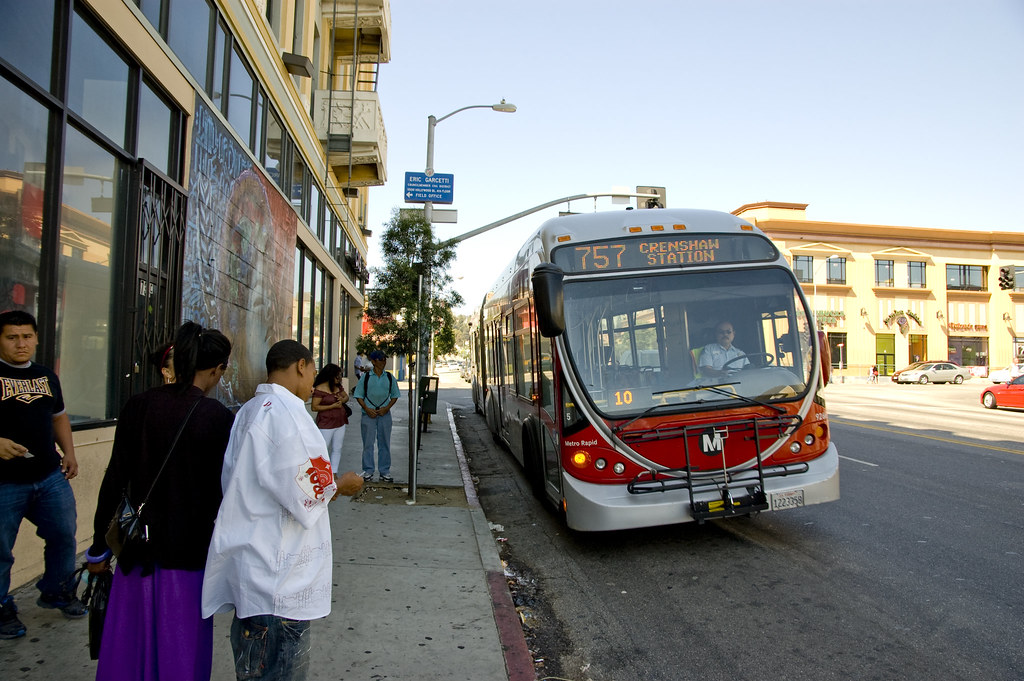「等公車的地方通常是城市空氣污染相當嚴重的地方,靠近十字路口處,汽車、卡車和公車不斷停下來又加速,噴出高濃度的有害廢氣。」加州大學洛杉磯分校(UCLA)大氣科學教授鮑爾森(Suzanne Paulson)發現了等公車的空污隱憂。
在許多城市,無論是在美國還是在其他國家,等公車都可能需要15到25分鐘,甚至更久。鮑爾森主導的研究顯示,讓公車停靠站遠離十字路口,可顯著減少乘客接觸到的空氣污染。
鮑爾森說:「廢氣中含有氣體和大量超細顆粒,這些顆粒基本上不受環保局的管制,因為EPA以重量管制懸浮顆粒,而這些顆粒重量很輕。我們的測量顯示,交通相關的污染物濃度在十字路口附近達到峰值,並隨著距離而急劇下降。」
他的研究團隊指出,只要將公車和輕軌站點從繁忙的十字路口移開120英尺,乘客接觸到的污染物可大大減少。他們的研究在本月稍早刊登在「環境污染」(Environmental Pollution)期刊。
研究人員使用配備專門儀器的零排放車輛來測量超細顆粒和其他排氣管排出的污染物,如氮氧化物和一氧化碳。他們在洛杉磯和周邊地區的幾個街區進行測量,包括洛杉磯市中心、比佛利山莊和聖蓋博山谷。
研究時段包括2013年夏季進行到深秋,為期15天,以及2014年夏季四天多。研究人員駕車於早上和下午時段,在十個有交通號誌的交叉路口之間來回開,共計1744趟,每秒鐘進行一次測量。
主要作者、韓國釜山大學環境大氣科學助理教授Wonsik Choi說:「接著,我們將每個十字路口的資料合併和分析,建立高解析度的污染物濃度地圖。」研究人員計算了如果停靠站位於離十字路口較遠處,等車乘客會吸入的超細粒子和其他交通相關污染物數量。
同時也是加州大學洛杉磯分校環境與永續發展研究所成員的鮑爾森說:「除了交通流量最小的區域外,這個作法能大幅減少其他區域等車乘客接觸的空污量。」鮑爾森強調,在交叉路口附近,垃圾車和其他大型車輛起步和止步時,會噴出更多的廢氣。
加州大學洛杉磯分校的研究人員發現,道路污染物濃度一般在交叉口±30公尺內達到峰值,接著隨距離急劇下降。如將站牌設在距離十字路口40-50公尺處,可以顯著減少暴露於超細顆粒的機會。
交通工程師認為,公車站位於十字路口之後交通流量會更好,也就是說停車機會可減少,如此也可以改善空氣品質。
研究人員表示,在都會區,將公車站稍微遠離十字路口,可以減少等車者呼吸到的空氣污染,只要不要遠到開始接觸到下一個路口的污染。
Moving bus stops away from intersections would reduce the amount of pollution to which bus riders are exposed, scientists from the University of California Los Angeles report.
In many cities, both in the United States and internationally, bus riders can spend 15 to 25 minutes or more each way waiting for their bus.
“The wait often means spending time in some of the most polluted locations in cities, close to intersections where cars, trucks and buses are continually stopping and accelerating, spewing out high concentrations of noxious exhaust,” said senior author Suzanne Paulson, UCLA professor of atmospheric sciences.
“The exhaust contains gases and large amounts of ultrafine particles that are essentially unregulated by the Environmental Protection Agency because the EPA regulates fine particles by weight, and these particles weigh so little,” Paulson said.
“Our measurements show that traffic-related pollutant concentrations peak near intersections and decrease sharply with distance,” she said.
Bus riders’ exposure to the pollutants would be much reduced by moving bus and light rail stops 120 feet away from busy intersections, her research team reports.
The researchers used a zero-emission vehicle equipped with specialized instruments to measure ultrafine particles and other tailpipe pollutants, such as nitrogen oxide and carbon monoxide.
They made measurements in several neighborhoods in Los Angeles and surrounding areas, including downtown Los Angeles, Beverly Hills and the San Gabriel Valley.
The research was conducted on 15 days from summer to late fall in 2013 and over four days in the summer of 2014.
Their report was publlished earlier this month in the journal “Environmental Pollution.”
The researchers drove back and forth across 10 intersections with traffic signals and nearby street blocks during mornings and afternoons, 1,744 times, taking measurements every second.
“We then combined and analyzed the data for each intersection to create high-resolution maps of pollutant concentrations along the blocks,” said Choi, an assistant professor of environmental atmospheric sciences at South Korea’s Pusan National University.
The researchers calculated the quantity of ultrafine particles and other traffic-related pollutants transit users would inhale if the stop was farther from the intersection.
“Except in areas with minimal traffic, we always found there would be a significant reduction,” said Paulson, who is also a member of UCLA’s Institute of the Environment and Sustainability.
She noted that trash trucks and other large vehicles spew much more toxic fumes near intersections, when they are starting and stopping.
The UCLA researchers found that roadway pollutant concentrations generally peak within ±30 meters from intersections. Pollutant concentrations decrease sharply with distance.
They found that placing bus stops 40–50 meters from intersections significantly reduces exposure to ultrafine particles.
Traffic engineers believe that traffic flows better if bus stops are located after intersections. Better traffic flow can mean less stop-and-go, which can also improve air quality.
In urban areas, the researchers said, moving the stops farther away reduces the amount of pollution transit users breathe, as long as the stop is not so far that it gets pollution from the next street.
※ 全文及圖片詳見:ENS






